|
The Iloca Aut-o-matic can be regarded as the final Iloca Rapid, as it is very similar to the Iloca Rapid IIR and III. However, it had a new feature, a coupled light meter, hence the name Aut-o-Matic. By turning a small wheel at the base of the lens one changes the aperture-shutter combination and a dial moves in the light meter window. Turning the wheel until this dial aligns with the light meter needle sets the right exposure. This system was similar to that on the Kodak Retina IIS, IIIS and Reflex cameras.
The Iloca Aut-o-matic is most commonly found with a Steinheil Cassarit f/2.8 lens but it was also available with Rodenstock Ysarex f/2.8 or Heligon f/2 lens. It was also sold under the Photrix name.
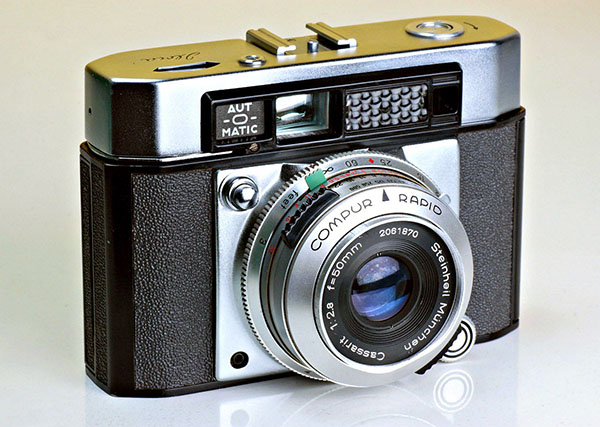
An lloca Aut-o-matic made in the third quarter of 1959 with Steinheil Cassarit 50mm f/2.8 in Compur-Rapid shutter.
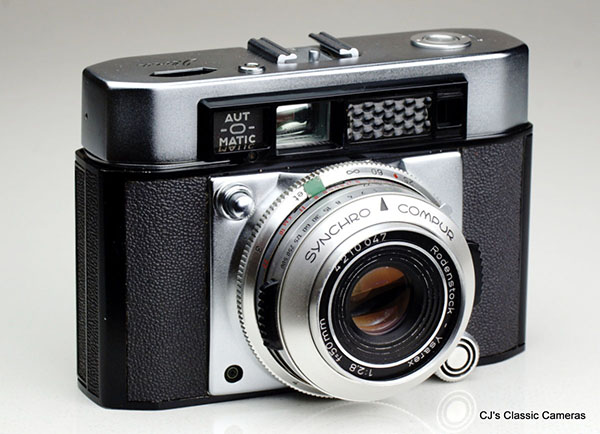
A nearly identical lloca Aut-o-matic, but here with Rodenstock Ysarex 50mm f/2.8 lens in Synchro-Compur shutter.
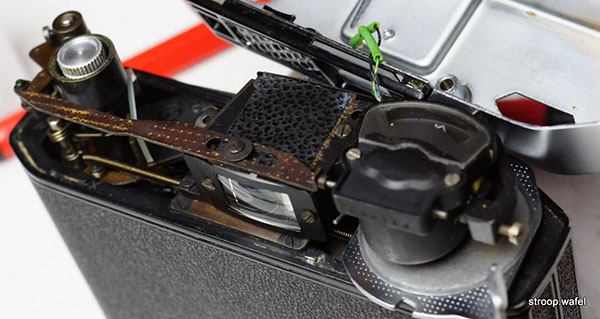
Close-up of the lever mechanism that transfers the exposure settings to the light meter (seen from the back of the camera). Also visible is the very long spring pulling the rapid winder and the rangefinder. The latter can be adjusted through a hole in the top housing which can be accessed by removing the accessory shoe. A small hole in the side of the camera allowed adjustment of the coupled lightmeter.
The Iloca Electric was the last lloca model to reach the shops. At the end of the 1950s the heydays of German camera manufacturing were nearly over and many German camera companies reverted to producing cheap plastic models shortly after. But Iloca had one final trick on its sleeve, the Iloca Electric. This had an electric motor wind, the first camera to do so, and an interchangeable lens mount. However, Iloca had trouble sourcing shutters, probably because the shutter market was monopolised by its competitors. Iloca went bust and its remains were taken over by Agfa, who not long after introduced the Selecta-m. This camera was clearly based on the Iloca Electric but without the interchangeable lens mount. It was very similar also to an Iloca prototype, the Auto-Electric, of which only a few examples exist. So even though Iloca did not survive, some of its novel technology did.
The lloca Electric was a very expensive camera and sold in only small numbers. Its biggest market was the U.S.A., where Graflex sold the camera rebranded as Graphic 35 Electric. Due to their scarcity the lloca Electric 'proper' fetches these days considerably higher prices than the Graflex version.

An Iloca Electric made in the second quarter of 1959 with interchangeable Iloca-Quinon 50mm f/1.9 by Steinheil. Quinons are mostly known in Exakta and m42 mount, the only other rangefinder Quinon I am aware of was the one made for the King Regula Super range, but the latter was mounted in a Prontor shutter whereas the Iloca has the more common Compur Deckel mount. Other cameras from that era with the same mount used different brands for their fast lenses (e.g., Schneider Xenons on the Kodak Retina IIIS and Reflex S, III and IV, Balda Baldamatic III and Edixa Electronica; Enna Ennalyt on the Braun Super III). A fast Rodenstock Heligon 50/1.9 was also avaible for the Iloca Electric.
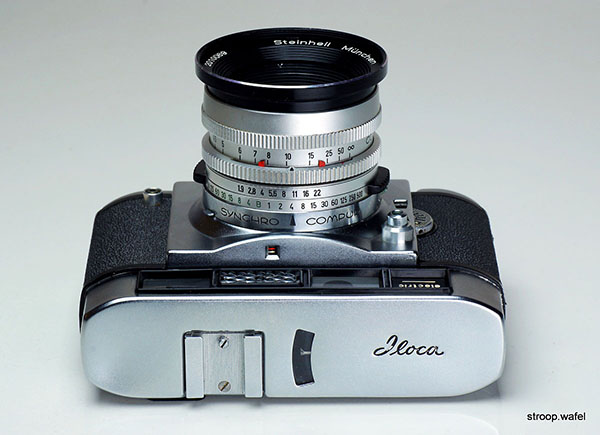
Top view of the Iloca Electric showing the lighmeter window. A nice feature of the Iloca Electric was that the lightmeter needle was projected at the top of the viewfinder window, so one could adjust the exposure without the need of taking one's eye of the viewfinder.
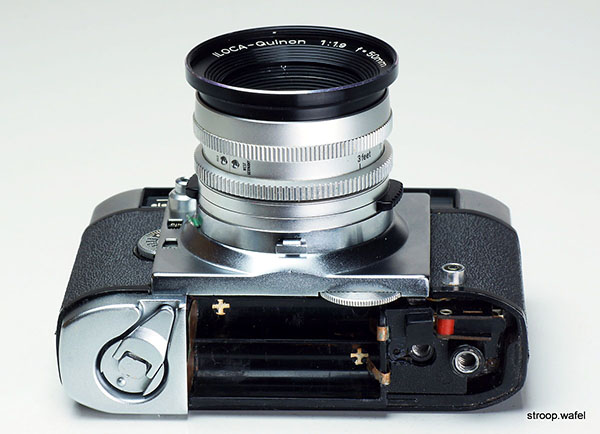
Bottom view of Iloca Electric. Just right of the middle, below the lens mount, the exposure adjustment wheel is visible. Its function was similar to that of the Retina IIS, IIIS and various Reflex models: turning it would adjust the shutter speed at fixed aperture, the correct exposure was reached if the light meter needle would align with the white marker.
Also note the open battery compartment. The camera took 2 AA batteries and according the manual these would last about a 1000 exposures. Obviously without them the camera will not work at all. Unfortunately many Iloca/Graphic 35 Electric have been damaged by leakage from empty batteries that have been left in the camera.
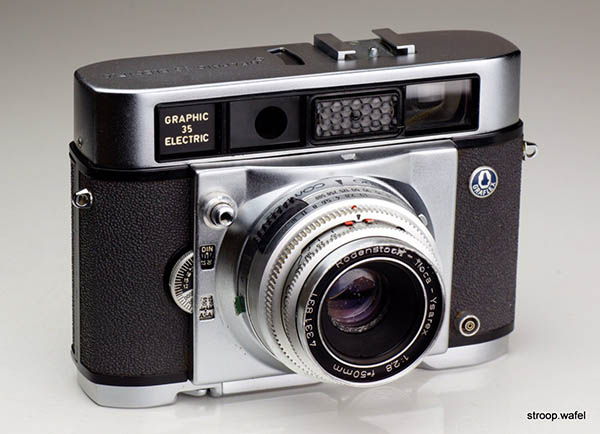
An Iloca Electric rebranded Graphic 35 Electric and sold by Graflex in the U.S. This example is from the fourth quarter of 1959 and features an interchangeable Rodenstock-Iloca-Ysarex 50mm f/2.8 lens, which has seen better days. There were some small differences with the Iloca version, the most obvious ones the presence of strap lugs and the little Graflex emblem on the front. The insides of the cameras also show some small differences, but most likely these were just small improvements made during production of both models.

Rear view of Iloca/Graphic 35 Electric. Removing the back was not self-explanatory, one would have to push to the left the little tab just about visible near the bottom right corner and the rewind lever would pop out (see bottom view). Then one would have to keep the little tab pushed to the left whilst pulling the rewind lever down, this would pop open the camera back cover. The wind motor was inside the wind spool on the left.
The lens mount of the Iloca Electric was a so-called Deckel mount, similar to that of the Kodak Retina IIIS, most Retina Reflex cameras and the Balda Baldamatic III. However, the lenses weren't truly interchangeable as the mounts differed slightly presumably because of competition considerations. Nevertheless, they could easily be made to fit by filing away small notches, as long as the aperture control lever was located in the same place for both mounts. Modern adapters to fit these lenses to digital cameras generally fit lenses from most brands.
The similarities of the lens mount mean that the lenses themselves are virtually identical. For example, the Rodenstock-Iloca-Ysarex and Rodenstock-Iloca-Rotelar are optically identical to the Kodak Retina versions.

Graphic 35 Electric with Rodenstock-Iloca-Rotelar 135mm f/4 lens mounted.
The Iloca Auto-Electric was the last camera designed by Iloca. As mentioned above, it was based on the Iloca Electric but had an automatic exposure mode, a novelty at the time, and had a fixed lens mount. It never reached production due to Iloca's bankruptcy, but was reincarnated in the Agfa Selecta-m a few years later. More details can be found in the Agfa non-Karat section.
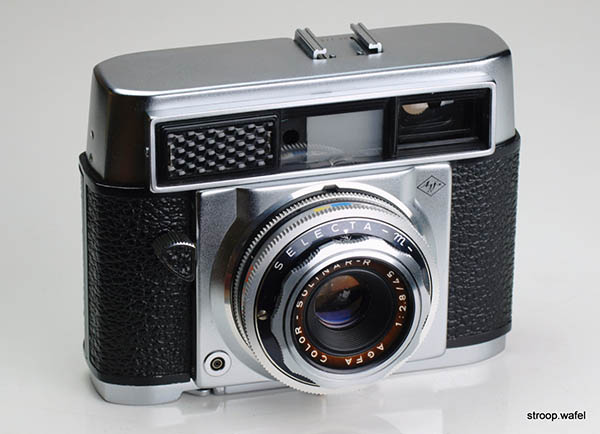
An Agfa Selecta-m, developed from and looking similar to the Iloca Auto-Electric.
| 
